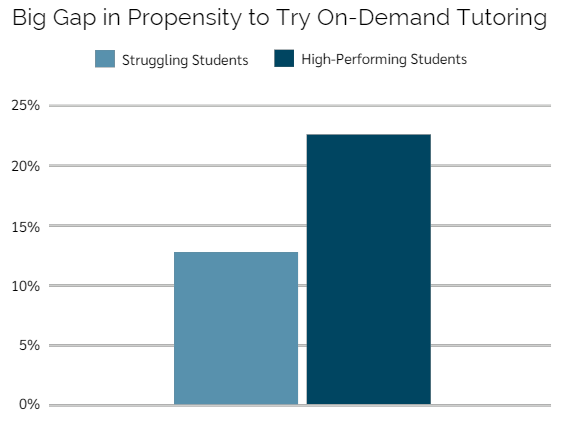K12—Research
Improving Equity through High-Dosage Tutoring (HDT)
A 2022 research study has shown that high-dosage tutoring (HDT) outperformed on-demand tutoring in terms of academic outcomes since more students access tutoring when it occurs during the school day on an ongoing basis. Researchers from Brown University ran a randomized controlled trial at Aspire Public Schools, a charter district in California, with about 7,000 students, 75% of whom qualify for free/reduced lunch. Nearly all were eligible for free virtual tutoring with an online whiteboard and text chat feature.
Key Takeaways from the Research
- On-demand tutoring adoption is often lower than desired or planned.
- High-achieving students will opt-in to tutoring much more often than struggling students.
- The “opt-in approach” to tutoring exacerbates inequality.
According to the report, on-demand tutoring perpetuates inequality. The researchers share, “We found that the vast majority of students do not take-up an opt-in educational resource, even when it can promote learning, and that struggling students are the least motivated to proactively access and benefit from the additional support.” Without targeted interventions, struggling students are unlikely to opt-in to the supports and will continue to fall behind as high-achieving students benefit from the resource.

Benefits and Challenges of Tutoring Formats
Benefits
On-Demand Tutoring
- Logistical benefits: fills gaps in off hours; doesn’t require scheduling; high convenience
- Positively impacts grades and other academic outcomes
- With best practices, up to 46% will participate
High- Dosage Tutoring (HDT)
- Ensures nearly all students access tutoring
- Much more structure and benefit from tutoring: same tutor; many more sessions (up to 30)
- Overcomes barriers to inequality by providing reinforcement and structure
Challenges
On-Demand Tutoring
- Despite appearance of equal access, it in fact perpetuates inequality; higher performing students are more likely to adopt
- Average sessions for those who access on-demand: 4
- Best practices require messaging both students and parents regularly through school season; if not followed, adoption may be 50% lower (about 20% or less)
High- Dosage Tutoring (HDT)
- Takes coordination work: finding facilities and shepherding students to the location
- Requires on-site access to computing resources



